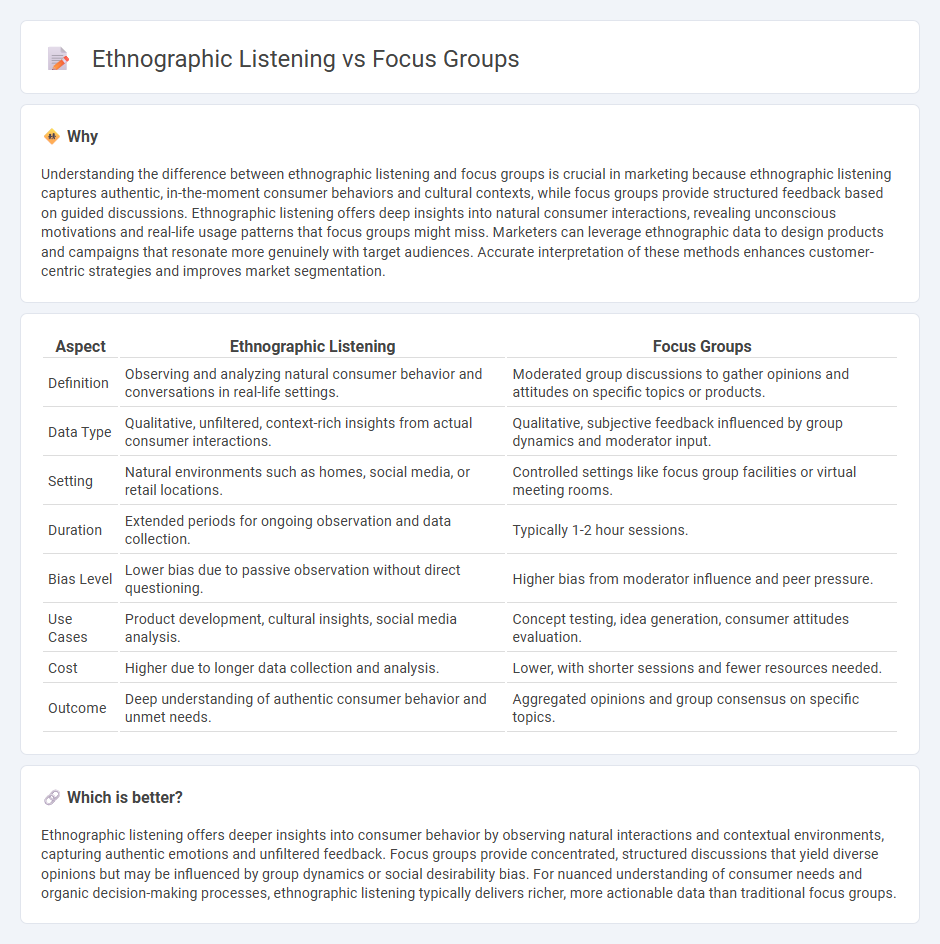
Ethnographic listening involves observing and understanding consumer behavior in their natural environment to uncover authentic insights, while focus groups gather targeted feedback through guided discussions among selected participants. Ethnographic methods provide in-depth, contextual data reflecting real-life experiences, contrasting with the structured, opinion-driven format of focus groups. Discover how leveraging these approaches can enhance your marketing strategies.
Why it is important
Understanding the difference between ethnographic listening and focus groups is crucial in marketing because ethnographic listening captures authentic, in-the-moment consumer behaviors and cultural contexts, while focus groups provide structured feedback based on guided discussions. Ethnographic listening offers deep insights into natural consumer interactions, revealing unconscious motivations and real-life usage patterns that focus groups might miss. Marketers can leverage ethnographic data to design products and campaigns that resonate more genuinely with target audiences. Accurate interpretation of these methods enhances customer-centric strategies and improves market segmentation.
Comparison Table
| Aspect | Ethnographic Listening | Focus Groups |
|---|---|---|
| Definition | Observing and analyzing natural consumer behavior and conversations in real-life settings. | Moderated group discussions to gather opinions and attitudes on specific topics or products. |
| Data Type | Qualitative, unfiltered, context-rich insights from actual consumer interactions. | Qualitative, subjective feedback influenced by group dynamics and moderator input. |
| Setting | Natural environments such as homes, social media, or retail locations. | Controlled settings like focus group facilities or virtual meeting rooms. |
| Duration | Extended periods for ongoing observation and data collection. | Typically 1-2 hour sessions. |
| Bias Level | Lower bias due to passive observation without direct questioning. | Higher bias from moderator influence and peer pressure. |
| Use Cases | Product development, cultural insights, social media analysis. | Concept testing, idea generation, consumer attitudes evaluation. |
| Cost | Higher due to longer data collection and analysis. | Lower, with shorter sessions and fewer resources needed. |
| Outcome | Deep understanding of authentic consumer behavior and unmet needs. | Aggregated opinions and group consensus on specific topics. |
Which is better?
Ethnographic listening offers deeper insights into consumer behavior by observing natural interactions and contextual environments, capturing authentic emotions and unfiltered feedback. Focus groups provide concentrated, structured discussions that yield diverse opinions but may be influenced by group dynamics or social desirability bias. For nuanced understanding of consumer needs and organic decision-making processes, ethnographic listening typically delivers richer, more actionable data than traditional focus groups.
Connection
Ethnographic listening involves observing and interpreting consumer behavior in natural settings, providing deep insights into cultural and social contexts that influence buying decisions. Focus groups complement this by facilitating direct interaction with target audiences, allowing marketers to explore attitudes and perceptions revealed through ethnographic research. Together, these methods create a comprehensive understanding of consumer motivations, enhancing the effectiveness of marketing strategies.
Key Terms
Qualitative research
Focus groups provide structured qualitative insights by gathering diverse participants to discuss specific topics in a controlled setting, enabling researchers to capture group dynamics and immediate reactions. Ethnographic listening involves immersive, long-term observation of participants in their natural environments, offering deeper understanding of behaviors, context, and cultural nuances. Explore more to determine which qualitative research method aligns best with your project goals and data needs.
Consumer insights
Focus groups provide structured consumer insights through guided discussions, enabling the collection of direct feedback on products, services, or brand perceptions. Ethnographic listening captures authentic consumer behaviors and emotions by observing real-life interactions and cultural contexts, offering deeper, unfiltered understanding. Discover how combining these methods can enhance your consumer insight strategy.
Data collection
Focus groups gather qualitative data by engaging a small, diverse group of participants in structured discussions to explore opinions, attitudes, and motivations. Ethnographic listening involves immersive observation and real-time data collection within participants' natural environments, providing deeper contextual insights into behavior and cultural norms. Discover more about how these data collection methods can enhance your research strategy.
Source and External Links
What Is a Focus Group? Definition and Guide (2024) - A focus group is a market research method where 6-10 people discuss a product, service, or concept, providing interactive, nuanced feedback under the guidance of a trained moderator in a controlled environment.
Focus Groups - Focus groups consist of individuals sharing a common characteristic who participate in a moderated discussion to offer insights into their collective perspectives and experiences on specific topics.
Focus Group - Organized to gather opinions and feedback on a topic, focus groups are commonly used in market research, policy-making, and public engagement, with a moderator guiding the discussion through a mix of open and closed questions.
 dowidth.com
dowidth.com